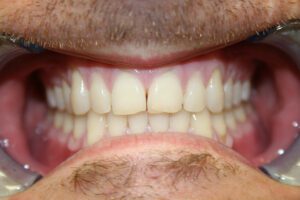Dental fillings and crowns preserve and protect your teeth in case of structural damage. If decays and cavities threaten to ruin your smile, consider these basic treatments to restore oral health.
Learn more about dental fillings and crowns to learn how to protect your teeth from damage and ensure their longevity.
What Are Dental Fillings?
Cavities, or dental caries, are areas of your teeth damaged and eroded by acid-producing bacteria. Bad oral hygiene, too much sweets, and ignoring regular dental check-ups will cause their formation.
Dental fillings restore the teeth affected by mild to moderate decay. These decayed portions are removed, filling the resulting void with appropriate materials. The choice of filling material depends on location, severity, and aesthetic preferences.
Types of Dental Fillings
You can choose from different filling materials. Each material has pros and cons, so consider it carefully before deciding.
- Amalgam fillings: This type of filling mixes several metals. They are enduring and affordable but less pleasing to look at than others.
- Resin fillings: This filling matches your natural tooth color but may not cover large cavities. Smaller cavities may suit resin fillings more.
- Ceramic fillings: These are not the most common option; they are biocompatible and offer excellent aesthetics.
What Are Dental Crowns?
In cases of substantial tooth damage, such as cracks, fractures, or extensive decay, dental fillings may not suffice. Dental crowns become an option when a tooth’s structure needs comprehensive protection and reinforcement.
A crown is a structure resembling a cap that covers the tooth, visible above the gumline. Dental crowns repair damaged teeth and improve their appearance. It gives the compromised tooth strength, stability, and protection, allowing it to function normally.
Types of Dental Crowns
Like fillings, different materials are available for dental crowns. Some of the more common ones are:
- Porcelain crowns: This type looks exceptionally pleasing and closely resembles natural teeth.
- Metal crowns: Usually made of gold or silver, this crown type is more easily noticed. But they are strong and durable.
- Fusion crowns: Porcelain mixed with metal combines beauty and strength, fit for front and back teeth.
Follow-up Maintenance after the Procedures
Your dental fillings and crowns can last for a long time if you treat them carefully. Of course, their lifespans also depend on the material and your bite forces. If you wish to maintain your restoration for a long time, carefully care for your teeth with strict oral hygiene.
Aside from scheduling routine appointments with your dentist for further monitoring, here are ways you can maintain your fillings and crown:
- Brush and floss more carefully to avoid damaging the restored teeth.
- Avoid hard-to-chew foods to prevent unnecessary stress on your teeth.
- Avoid grinding your teeth as they wear down on the fillings and crowns faster.
- Consider using a nightguard if you habitually grind your teeth during sleep.
Restore the Natural Beauty of Your Teeth
Damaged teeth affect your health in a myriad of ways. Dental fillings and crowns are treatments you can consider to repair and restore your teeth functionality and natural beauty. Consult your dentist to find out how dental fillings and crowns can protect your everlasting smile.

